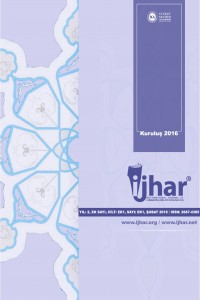Abstract
When Benjamin Franklin carried out his well-known kite experiment in 1752, he had a strong feeling that along with light photons, there were other concepts traversing distances in a blink of an eye. The discovery of electricity was one of the biggest achievements in civilization. As human beings, we have always dreamed to reduce distances and to be as fast as we can. The supersonic aircrafts, the high-speed trains or fast cars are all the reflections of this vision. Even in ancient times, before electricity and other technological improvements, faster tamed birds, which reduced the distance, were used to communicate between people. The distance has always been an obstacle between us and the people or concepts that we would like to reach, but the progress welcomes us when we overcome these obstacles. Education is also an important area that we are eager to solve distance-based problems. However, it was the 20th century that technology and mass communication enabled alternatives to traditional offline learning. Although education was an important area in which we were eager to solve distance-based problems, it took the 20th century for technology and mass communication to provide alternatives to traditional offline learning. Distance learning “is a form of education which does not involve the physical presence of a teacher and is not carried out within the framework of a school establishment”, according to the definition given by service-public.fr, official site of the French administration. In other words, distance learning is accessible wherever you are, in the presence of other participants or not. There are two forms of distance learning first of which is the so-called synchronous distance learning. It is a virtual class; it takes place in real time. You are attending a videoconference according to a defined schedule. The second one is the so-called asynchronous distance learning. Lessons take place offline. You have access to your courses in pdf or video format, they are accessible at any time. Distance learning makes education accessible to as many people as possible. It is intended for anyone who wishes to acquire new skills and new knowledge throughout their life. Although most universities around the world have programs that allow students to study through distance education, their numbers were not as high as the ones which have occurred in the first quarter of the 2020. The fact that large number of students have started to take part in the distance education has brought some important problems with the process and needs to be examined. For this reason, this study aims to compare the distance education process at a foreign language school of a public university and online exams conducted on the basis of Microsoft Teams software and traditional paper-based exams and interpret them from an instructor perspective. In this paper, it has been analyzed the use of Microsoft Teams as the major distant education support which is a proprietary collaborative communication (SaaS) application officially launched by Microsoft in November 2016. The service integrates with Microsoft Office 365 and Skype and offers extensions that can be used with products other than Microsoft. It is currently available in 181 countries and is translated into 25 languages. Microsoft Teams is a customizable collaborative platform that integrates video conferencing, file storage and transfer with SharePoint, a note taking block with OneNote. Instant messaging allowing to exchange in a team or in a work group while keeping a record of all exchanges. The research is conducted in descriptive survey, which is one of the quantitative research designs. The data was gathered through students’ exam papers. The study was conducted with 21 prep -class students. The study group was chosen through purposeful sampling. They were all French preparation class students. At the end of the study, the results showed that the distance education process at a public university and online exams conducted on the basis of Microsoft Teams software have been more effective and successful than traditional ones.
References
- Falcone , J. (2020, May 21). Microsoft Teams: 7 things you need to know. Retrieved from CNET: https://www.cnet.com/news/microsoft-teams-7-things-you-need-to-know/
- Burkhardt, A. (2020, June 02). Historique de la formation à distance. Retrieved from Betterstudy Swiss Online Education: https://betterstudy.ch/historique-de-la-formation-a-distance/
- ENACO. (2016, July 18). Le cours par correspondance : qu'est-ce que c'est ? Retrieved from ENACO: https://www.enaco.fr/quest-ce-que-la-formation-a-distance/
- Kwisnek, V. F. (2005). Assessing the effectiveness of e-learning. In P. Darbyshire (dir.), Instructional Technologies: Cognitive Aspects of Online Programms. Hershey, PA: IRM Press, 192-220.
- Maeroff, G. I. (2003). A classroom of one: How online learning is changing our schools and colleges. New York: Palgrave Macmillan.
- service-public.fr. (2020, June 01). École à la maison. Retrieved from service-public.fr: https://www.service-public.fr/particuliers/vosdroits/F23429
Abstract
Benjamin Franklin 1752’de tanınmış uçurtma denemesini gerçekleştirdiğinde, ışık fotonlarıyla birlikte göz açıp kapayıncaya kadar mesafeleri aşan başka kavramlar olduğu yönünde güçlü bir öngörüsü olduğunu ifade etmişti. Elektriğin keşfi medeniyetteki en büyük başarılardan biriydi. İnsanlar olarak, her zaman mesafeleri azaltmayı ve olabildiğince hızlı olmayı hayal ettik. Süpersonik uçaklar, yüksek hızlı trenler veya hızlı arabalar bu vizyonun yansımalarıdır. Eski zamanlarda bile, elektrik ve diğer teknolojik gelişmelerden önce, mesafeyi azaltan daha hızlı evcilleştirilen kuşlar, insanlar arasında iletişim kurmak için kullanıldı. Uzaklık her zaman aramızda bulunmak istediğimiz insanlar veya kavramlar arasında bir engel olmuştur, ancak bu engelleri aştığımızda ilerleme bizi karşılamaktadır. Bu ilerlemeyi hayatın birçok alanında görmek insanoğlunun son yüzyılda başarmak istediği emellerden biridir. Eğitim de diğer alanlarda olduğu gibi, mesafeye dayalı sorunları çözmeye istekli olduğumuz önemli bir alandır. Bununla birlikte, teknoloji ve kitle iletişiminin geleneksel çevrimdışı öğrenmeye alternatifler sağlayabilmesi 20. Yüzyıla kadar gerçekleşememiştir. Geleneksel öğrenmeye alternatif olarak üretilen en etkili eğitim süreci uzaktan eğitim olmuştur. Uzaktan eğitim, bir öğretmenin fiziksel varlığını içermeyen ve bir okul kuruluşu çerçevesinde yürütülmeyen bir eğitim şekli olarak ifade edilmektedir. Diğer bir deyişle, uzaktan eğitim, nerede olursanız olun, diğer katılımcılar olsun olmasın erişilebilen eğitim şeklidir. Uzaktan eğitimin iki şekli vardır, bunlardan ilki senkron uzaktan eğitimdir. Sanal bir sınıftır; gerçek zamanlı olarak gerçekleşir. Belirli bir programa göre bir video konferansa katılıyorsunuz. İkincisi, eşzamansız uzaktan öğrenmedir. Dersler çevrimdışı yapılır. Ders kapsamında kullanılan belgelere pdf veya video formatında erişebilir ve bu kurslara öğrenciler istedikleri her zaman, her yerden ulaşabilmektedir. Uzaktan eğitim, eğitimi mümkün olduğunca çok kişi için erişilebilir hale getirir. Uzaktan eğitim süreci yaşamları boyunca yeni beceriler ve yeni bilgiler edinmek isteyen herkes için tasarlanmıştır. Dünyanın dört bir yanındaki üniversitelerin çoğunda, öğrencilerin uzaktan eğitim yoluyla çalışmalarına izin veren programlar olmasına rağmen, sayıları 21. Yüzyılın ilk çeyreğine kadar istenilen seviyede olmadığı bilinen bir gerçektir. Bu kadar çok sayıda öğrenci zamanla uzaktan eğitim sürecine artarak dahil olduğundan bu durum bazı önemli sorunlar getirmiştir ve eğitimciler ve eğitim planlayıcılarının karşılaştığı bu sorunların incelenmesi bir gereklilik halini almıştır. Bu bilgiler ışığında gerçekleştirilen, bu çalışma bir devlet üniversitesinin yabancı diller yüksekokulundaki uzaktan eğitim sürecini ve Microsoft Teams yazılımı ile geleneksel kağıt tabanlı sınavlar temelinde yapılan çevrimiçi sınavları karşılaştırmayı amaçlamaktadır. Bu çalışmada, Microsoft Teams’in Kasım 2016’da resmi olarak Microsoft tarafından başlatılan özel bir ortak iletişim (SaaS) uygulaması olan ana uzaktan eğitim desteği olarak kullanımını analiz edilmiştir. Hizmet, Microsoft Office 365 ve Skype ile entegre olmaktadır ve Microsoft dışındaki ürünlerle birlikte kullanılabilmektedir. Şu anda 181 ülkede mevcuttur ve 25 dile çevrilmiştir. Microsoft Teams, video konferansı, dosya depolama ve aktarımı OneNote ile bir not alma bloğu olan SharePoint ile entegre eden özelleştirilebilir bir işbirliği platformudur. Tüm etkileşimlerin kaydını tutarken bir ekipte veya çalışma grubunda değişim yapmaya izin veren anlık mesajlaşma uygulaması da bulunmaktadır.
Araştırma nicel araştırma tasarımlarından biri olan betimsel araştırmada yürütülmektedir. Veriler öğrencilerin sınav kağıtları aracılığıyla toplanmıştır. Çalışma 21 hazırlık sınıfı öğrencisi ile gerçekleştirilmiştir. Çalışma grubu amaçlı örnekleme ile seçilmiştir. Hepsi Fransız hazırlık sınıfı öğrencisidir. Çalışmanın sonunda, sonuçlar bir devlet üniversitesindeki uzaktan eğitim sürecinin ve Microsoft Teams yazılımı temelinde yapılan çevrimiçi sınavların geleneksel olanlardan daha etkili ve başarılı olduğunu göstermiştir.
Keywords
References
- Falcone , J. (2020, May 21). Microsoft Teams: 7 things you need to know. Retrieved from CNET: https://www.cnet.com/news/microsoft-teams-7-things-you-need-to-know/
- Burkhardt, A. (2020, June 02). Historique de la formation à distance. Retrieved from Betterstudy Swiss Online Education: https://betterstudy.ch/historique-de-la-formation-a-distance/
- ENACO. (2016, July 18). Le cours par correspondance : qu'est-ce que c'est ? Retrieved from ENACO: https://www.enaco.fr/quest-ce-que-la-formation-a-distance/
- Kwisnek, V. F. (2005). Assessing the effectiveness of e-learning. In P. Darbyshire (dir.), Instructional Technologies: Cognitive Aspects of Online Programms. Hershey, PA: IRM Press, 192-220.
- Maeroff, G. I. (2003). A classroom of one: How online learning is changing our schools and colleges. New York: Palgrave Macmillan.
- service-public.fr. (2020, June 01). École à la maison. Retrieved from service-public.fr: https://www.service-public.fr/particuliers/vosdroits/F23429
Details
| Primary Language | English |
|---|---|
| Journal Section | Research Articles |
| Authors | |
| Publication Date | February 20, 2018 |
| Submission Date | December 31, 2017 |
| Acceptance Date | February 12, 2018 |
| Published in Issue | Year 2018 Volume: EK 1 Issue: EK 1 |




International Journal of Human and Art Studies İJHAR; Licensed under the Creative Commons Attribution 4.0 International License.
International Journal of Human and Art Studies IJHAR has been registered with the decision of the Turkish Patent and Trademark Office, numbered 71248886-2020/24446 / E.2020-OE-458377.

